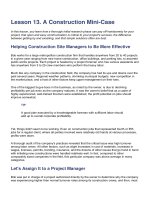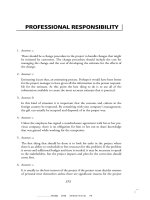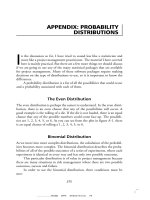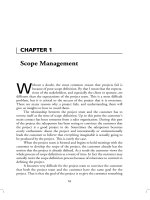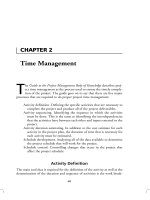Project Management Professional-Chapter 2
Bạn đang xem bản rút gọn của tài liệu. Xem và tải ngay bản đầy đủ của tài liệu tại đây (192.73 KB, 31 trang )
CHAPTER 2
Time Management
T
he Guide to the Project Management Body of Knowledge describes proj-
ect time management as the process used to ensure the timely comple-
tion of the project. The guide goes on to say that there are five major
processes that are required to do proper project time management:
Activity definition. Defining the specific activities that are necessary to
complete the project and produce all of the project deliverables.
Activity sequencing. Identifying the sequence in which the activities
must be done. This is the same as identifying the interdependencies
that the activities have between each other and inputs external to the
project.
Activity duration estimating. In addition to the cost estimate for each
activity in the project plan, the duration of time that is necessary for
each activity must be estimated.
Schedule development. Analyzing all of the data available to determine
the project schedule that will work for the project.
Schedule control. Controlling changes that occur in the project that
affect the project schedule.
Activity Definition
The main tool that is required for the definition of the activity as well as the
determination of the duration and sequence of activities is the work break-
46
47Time Management
down structure. If you recall, in our discussion of the work breakdown struc-
ture (WBS), we found that it was used to methodically break down the
project into manageable subprojects.
The end result of this breakdown process is the creation of the lowest
level of breakdown. This lowest level of breakdown comprises the individual
pieces of work that must be done to complete the project. Because the WBS
is a representation of the entire project in various levels of detail, it represents
all the work that must be done to complete the project. The WBS defines
the lowest level of control that the project manager is required to manage.
This is the work package level. From the viewpoint of the subproject man-
ager, this level of control may reach down to the work package, be broken
down further to the activity level or still further to the individual task level.
The WBS represents all of the work that the project team must do to
complete the project. Before the scheduling work can begin the scope state-
ment, the constraints and assumptions, and any other historical information
must be reviewed to be certain that the work definition is correct and com-
plete.
Activity Sequencing
The activity’s identity comes from the work breakdown structure. When the
WBS is completed, the bottom of the work breakdown structure defines the
individual pieces of work that are necessary to complete the project. These
individual pieces of work are the same items that become the activities in
the project schedule. One of the things that is done in the development of
the WBS is to check that each of the activities has inputs for the work
required. Each output from an activity is used by another activity or is re-
quired as a part of a project deliverable.
Dependencies can be categorized as mandatory, discretionary, or exter-
nal and can be restricted by constraints and assumptions. Mandatory de-
pendencies are those that are required as part of the nature of the work.
These dependencies are sometimes called ‘‘hard’’ dependencies. For example,
the walls of a house cannot be built until the foundation is completed.
Discretionary dependencies are those that are defined by management.
These are preferred ways of doing things and may be determined by past
experiences. External dependencies are those that are external to the project.
These are all of the inputs that are supplied by anyone or anything outside
the project.
.......................... 9618$$ $CH2 09-06-02 14:58:53 PS
48 Preparing for the Project Management Professional Certification Exam
Activity on Arrow Diagramming
Activity on arrow diagramming (AOA) is a network diagramming method
that is seldom used today. Still, there are a number of places where these can
still be seen. Nearly all, if not all, software programs that are available for
project management scheduling have stopped using this diagramming
method. Our discussion will be brief here because in the latest release of the
Guide to the PMBOK they are still present.
In activity on arrow diagrams the network diagram will always be
shown with the activity information on the arrows instead of in the nodes
of the diagram. The nodes of an activity on arrow diagram will always be
shown as circles. This diagramming nomenclature is always followed.
Each activity in the diagram has two events associated with it. These
events are of zero duration and are located at the beginning of the arrow and
at the end of the arrow. This means that there are three things associated
with each activity in the diagram: the activity description itself, the starting
event of the activity, and the ending event of the activity.
The one advantage of this diagramming method is that, since the arrow
is a line, the length of the line can be varied in proportion to the duration
of the activity. This can be helpful in recognizing the magnitude of the
duration of the activity. However, most project management professionals
feel that the complexity and difficulty in using this diagramming method is
not compensated for by this ability.
Since the arrows in the diagram in figure 2-1 represent the activities, it
is necessary to create dummy activities to show multiple dependencies in the
Figure 2-1. Activity on arrow diagram.
Event name
Date due
Event name
Date due
Activity
duration
.......................... 9618$$ $CH2 09-06-02 14:58:54 PS
49Time Management
Figure 2-2. Activity on node diagram.
lead/lag
Start
Finish
Name Name
Duration
Slack
Start
Finish
Duration
Slack
project being represented. In the diagram, activity C depends on the comple-
tion of activities B and D. In order to show this as a dummy activity, the
dotted line must be used.
Calculations of schedules using this diagramming method are a bit
more complicated than the activity on node network diagram (figure 2-2),
but the results will be the same.
Precedence Diagramming Method (PDM)
Precedence diagramming is the method currently being used in nearly all of
the project management scheduling software available today. This diagram
is used to explain the mechanics of scheduling.
Precedence diagrams can be easily recognized. The network diagram
will always be shown with the activity information on the nodes instead of
on the arrows of the diagram. The nodes of an activity on precedence dia-
gram will always be shown as rectangles. This diagramming form is always
followed.
In its simplest form the diagram contains boxes to indicate the activities
in the schedule and arrows connecting them. The boxes can contain any
activity information that is desired, and all of the project management sched-
uling software today has a great deal of flexibility in this regard. Today, all
of this is done through the use of computer software for project management
scheduling. The software allows you to annotate the boxes in the diagram
with nearly any information you desire. Color and symbols can be used
effectively to describe the diagram more fully.
The basic information normally included in the precedence diagram
.......................... 9618$$ $CH2 09-06-02 14:58:56 PS
50 Preparing for the Project Management Professional Certification Exam
boxes is the activity number, description, early start, early finish, late start,
late finish, and duration. The arrows connect the activities according to the
logic that is required by the project. The arrows indicate the logical order
that the activities may be worked on. The logic of the schedule can be
considered as two activity pairs at a time. A pair of activities is any two (and
only two) activities that are joined by an arrow. The tail (the part without
the head) of the arrow indicates the independent activity of the pair, and the
head of the arrow indicates the dependent activity. Reading the logic of the
diagram is easy if you keep this in mind and always consider the logical
relationships of the network two activities at a time.
By saying that a relationship exists between two and only two activities,
I do not mean to say that any activity cannot have more than one relation-
ship. An activity might have two or more predecessors, and it might have
two or more successors (figure 2-3).
Logical Relationships
Four logical relationships are possible. These relationships can be remem-
bered if you use the same statement to describe the relationship and simply
substitute the letters designating the relationship. The statement is: The in-
dependent activity must (first letter of the relationship) before the dependent
activity can (second letter of the relationship) (see figure 2-4).
Finish-Start Relationship (FS)
Most projects that you are likely to encounter will use the logical relationship
of finish-start more often than any other relationship. This relationship says:
The independent activity in the relationship must finish before the depen-
dent activity can start.
This simply says that where there are two activities connected by an
arrow, the one that is connected to the tail of the arrow must be finished
before the activity connected to the head of the arrow is allowed to start. It
does not say that the dependent activity must start then. The activity could
start later than that time, but it is not allowed to start any sooner than the
finish of the independent activity.
For example, I have two tasks to complete in my project. The project
is to construct a wedding cake. The tasks are to make the cake and put on
the frosting. The finish-start relationship says that I cannot start putting the
frosting on the cake until I have baked the cake layers. Notice that I could,
.......................... 9618$$ $CH2 09-06-02 14:58:56 PS
Figure 2-3. Precedence diagram.
Write Code
Mon 7/31/00
7 30 days
Fri 9/8/00
Purchase Hardware
Fri 7/14/00
5 3 days
Tue 7/18/00
Design Software
Mon 7/10/00
6 15 days
Fri 7/28/00
Evaluate and Select
Vendors
Mon 7/10/00
4 4 days
Thu 7/13/00
Test Hardware
Wed 7/19/00
9 10 days
Tue 8/1/00
Approval
from Stakeholders
Mon 7/3/00
2 5 days
Fri 7/7/00
Select Site
Mon 7/10/00
3 4 days
Thu 7/13/00
Installation
Complete—Approval
Fri 10/13/00
11 5 days
Thu 10/19/00
Integrate
Fri 9/15/00
10 20 days
Thu 10/12/00
Develop Project
Deliverables
Mon 6/12/00
1 15 days
Fri 6/30/00
Test
Mon 9/11/00
8 4 days
Thu 9/14/00
..........................9618$$$CH209-06-0214:58:57PS
51
Time Management
52 Preparing for the Project Management Professional Certification Exam
Figure 2-4. Precedence relationships.
A
B
A
C
D
E
F
G
H
FS+5
SS
FF
SF
A must finish before B starts + 5 days
Leads or lags add or subtract time to the arrowhead event.
C must start before D can start
E must finish before F can finish
G must start before H can finish
logically, put the frosting on any time after that. The relationship constricts
the start of the activity of frosting the cake to be no sooner than the finish of
baking the cake.
Start-Start Relationship (SS)
The start-start relationship is stated in the same way as the finish-start rela-
tionship except that the word start is substituted for finish. The relationship
is stated like this: The independent activity in the relationship must start
before the dependent activity can start.
This simply says that where there are two activities connected by an
arrow, the one that is connected to the tail of the arrow must start before
the activity connected to the head of the arrow is allowed to start. It does
not say that the dependent activity must start then. The activity could start
later than that time, but it is not allowed to start any sooner than the start
of the independent activity.
For example, I have two tasks to complete in my project. The project
is to construct a wedding cake. The task in this example is to apply the
frosting to the cake. I do not want to apply the frosting to the cake until the
master chef is on scene. The two tasks then are: (1) apply frosting to cake
.......................... 9618$$ $CH2 09-06-02 14:58:58 PS
TEAMFLY
Team-Fly
®
53Time Management
and (2) master chef supervises cake construction. The start-start relationship
says that I cannot start putting the frosting on the cake until I have the
master chef present. Notice that I could, logically, put the frosting on any
time after that. The relationship constricts the start of the activity of frosting
the cake to be no sooner than the beginning of the master chef supervising
the cake construction.
Finish-Finish Relationship (FF)
The finish-finish relationship is expressed in the same way as the finish-start
relationship except that the word finish is substituted for start. The relation-
ship is stated like this: The independent activity in the relationship must
finish before the dependent activity can finish.
This says that where there are two activities connected by an arrow, the
one that is connected to the tail of the arrow must finish before the activity
connected to the head of the arrow is allowed to finish. It does not say that
the dependent activity must finish then. The activity could finish later than
that time, but it is not allowed to finish any sooner than the finish of the
independent activity.
For example, I have two tasks to complete in my project. The project
is to construct a wedding cake. The task in this example is to apply the
frosting to the cake. I must have the master chef there until the frosting is
complete so that he or she can approve it. The master chef is then restricted
from finishing the supervising task until the frosting task is finished. The
two tasks then are: (1) apply frosting to cake and (2) master chef supervises
cake construction. The finish-finish relationship says that the master chef
cannot finish supervising the cake construction until the frosting is com-
pleted. Notice that I could, logically, have the master chef continue supervis-
ing after that. The relationship constricts the finish of the master chef
supervising activity to be no sooner than the finish of the frosting task.
Start-Finish Relationship (SF)
The start-finish relationship is very seldom used and has even been dropped
from some of the project management scheduling software packages. This
relationship is stated in the same sentence as the finish-start relationship
except that the words start and finish are substituted for finish and start. The
relationship is stated like this: The independent activity in the relationship
must start before the dependent activity can finish.
This says that where there are two activities connected by an arrow, the
one that is connected to the tail of the arrow must start before the activity
.......................... 9618$$ $CH2 09-06-02 14:58:59 PS
54 Preparing for the Project Management Professional Certification Exam
connected to the head of the arrow is allowed to finish. It does not say that
the dependent activity must finish then. The dependent activity could finish
later than that time, but it is not allowed to finish any sooner than the start
of the independent activity.
For an example, let’s use the wedding cake and the supervisor again.
The project is still to construct a wedding cake. The task in this example is
to apply the frosting to the cake. We do not want to finish applying the
frosting to the cake until the master chef is on the scene. The two tasks then
are: (1) apply frosting to cake and (2) master chef supervises cake construc-
tion. The start-start relationship says that I cannot start putting the frosting
on the cake until I have the master chef present. The start-finish relationship
says that I can start putting on the frosting of the cake before the master
chef is present, but I am not allowed to finish putting on the frosting until
the master chef has started supervising. Notice that I could, logically, start
putting the frosting on any time before the master chef begins to supervise.
The relationship constricts the finish of the activity of frosting the cake to
be no sooner than the beginning of the master chef supervising the cake
construction.
These relationships must be available to project managers and sched-
ulers in order to be able to schedule all of the real relationships that are
necessary to properly schedule a project. They are seldom used until attempts
are made to reduce total schedule time.
In the examples involving frosting the cake, I related the frosting of the
cake to the presence of the master chef to supervise the operations. At first
the relationship was a start-start relationship, in which the frosting operation
had to wait until the master chef began supervising. If we were trying to
shorten the schedule, one of the things that might help would be to change
the relationship between these to activities to a start-finish relationship. This
would allow the frosting of the cake to begin much sooner but still require
that the master chef supervise the completion of the task.
Leads and Lags
To complete our discussion of relationships between schedule activities we
must discuss leads and lags. Leads and lags are delays that are imposed in the
relationship between the independent and dependent activity. They can help
to shorten schedules as well as allow for delays between activities. Leads and
lags are designated by adding a plus for lags, and a minus for leads as well as
the number of time periods that the lead or lag adds to the schedule.
A lag causes the dependent activity of the pair of activities in the rela-
.......................... 9618$$ $CH2 09-06-02 14:58:59 PS
55Time Management
tionship to have a designated number of time periods added to the start or
finish of the dependent activity. A lead causes the dependent activity of the
pair of activities in the relationship to have a designated number of time
periods subtracted from the start or finish of the dependent activity.
For example, in the two activities previously discussed, baking the cake
and putting the frosting on the cake, we established a finish-start relationship
between the two activities. This said that we could not apply the frosting
until the cake was baked. This is all right if the baking the cake activity
included the time for the cake to cool. If it did not, and the cake activity
ended when it was removed from the oven, then it would be necessary to
insert a lag between the two activities. It is not possible to put the frosting
on a hot cake, since it would melt and make a mess. This may be necessary
because the cake baker would like to have closure on the baking activity and
go about doing other things, and we may not want him to be responsible
for waiting until the cake cools.
We would change the relationship from an FS to an FS ם 1. This
would force the schedule to allow one time period between completion of
the baking activity and the start of the frosting activity.
A lead, on the other hand, allows the dependent activity to start sooner
than the logical relationship would normally allow. In the example showing
the start-finish relationship, we wanted to show that the frosting activity
could start sooner in this relationship than if it used a start-start relationship.
The problem with the start-finish relationship is that the frosting activity
could start very much earlier than the supervising activity. The result of this
might mean that the person responsible for the frosting cannot get closure
on the activity until the master chef arrives. Another way to show this rela-
tionship is to make it an SS מ 1 relationship. This means that the frosting
operation could start as early as one time period before the master chef
arrives.
Diagramming Relationships
The convention used in network diagramming of relationships and leads
and lags is that the relationship is shown on the logical arrow only if it is not
a finish-start relationship. If there are no leads or lags, no designation is
given.
Project Start and Project Finish Events
Each activity in the diagram will always have a predecessor and a successor
if the following convention is used. The convention is to create two events,
.......................... 9618$$ $CH2 09-06-02 14:59:00 PS
56 Preparing for the Project Management Professional Certification Exam
the start of the project and the finish of the project. An event is a project
activity that has zero duration and marks a place of significance in the proj-
ect. Creating a start and finish event for the project allows all other activities
to have at least one predecessor and at least one successor. This convention
keeps the diagram tidy and avoids having multiple places in the diagram
where the project can start and finish. These are called ‘‘danglers.’’
Since nodes (the boxes) represent the activities in the diagram, it is not
necessary to create dummy activities to show multiple dependencies in the
project being represented. Notice that it is easy to show multiple relation-
ships between activities. Activity 4 in the diagram in figure 2-3 is dependent
on activity 1 and activity 2, as well as the start of the project.
Logical Precedence Diagram
At this point it is possible to lay out the logical relationships of the project
activities. The activities themselves came from the work breakdown struc-
ture. There should be a one-to-one correspondence between the activities
that resulted at the bottom of the work breakdown structure and the activi-
ties that are in the schedule. The logical relationship between the activities
is also determined in the development of the work breakdown structure. We
accomplished this when we developed the inputs and outputs for each task
in the work breakdown structure. Since inputs required for one task are the
outputs for another task, this gives us much of the information we need for
sequencing the order of the activities.
Activity Durations
The durations of the activities were developed when we estimated the
cost of the project. Again, this was done with the help of the work break-
down structure. When we broke the project down to the individual tasks
that had to be done in the project, we were able to do a bottom up estimate
on cost for the project. While estimating the cost of each of the tasks in the
project we must also estimate the duration for each tasks as well. The dura-
tion of a task will not necessarily be the same as the effort to do the task.
Effort is the number of people-hours needed to do the task and will
help us estimate cost. We speak of effort as being one hundred people-hours.
This means that I might have one person working on the task for one hun-
dred hours, or I might have one hundred people working on the task for
one hour.
Duration is the length of time that it takes to do a task. This would be
the number of days that one person or more actually work on the activity. If
.......................... 9618$$ $CH2 09-06-02 14:59:01 PS
57Time Management
a project activity is scheduled to be done on Monday and Tuesday by Mary
and Joe, Wednesday and Thursday by Madelyn and Joe, and Friday by
Nancy and Fran, the duration of the activity is five days. If a project activity
is scheduled to be done on Monday and Tuesday by Mary and Joe, no work
is scheduled on Wednesday and Thursday, and work is scheduled on Friday
for Nancy and Fran and on Monday and Tuesday for Madelyn and Joe, the
duration of the activity is still five days. Wednesday and Thursday are consid-
ered to be nonworking days and contribute nothing to the activity’s dura-
tion. This is a split activity. It is easy to think of this type of activity as being
two activities, or parts A and B of the same activity. The important thing is
to realize that the duration of the activity does not include the time when
the activity is not being worked.
The span of an activity is different from duration as well. Span is the
time that elapses between the start and finish of the activity. Span is simply
the number of days that go by between the start and finish of the activity,
regardless of whether or not the activity is being worked on.
Continuing the above example with Madeline, Joe, Nancy, and Fran,
note that the activity started on Monday of the first week and finished on
Tuesday of the second week. The span of the activity is seven days, the
duration of the activity is five days, and the effort of the activity is ten
people-days.
Fortunately for the sake of our sanity, project schedules are put together
without very much use of interrupted activities. This is usually an inefficient
way to schedule work. The interrupted activity is, however, often used in
adjusting schedules for problems that appear during project execution.
Building the Network Diagram
Now that we have the durations and logic of the project, we can actu-
ally build the schedule. A sequence of steps should be followed in developing
the schedule:
1. Create a list of the activities that are to be scheduled.
2. Assign a duration to each of the activities.
3. Determine the predecessor for each activity.
4. Calculate the forward pass, the early schedule for each activity.
5. Calculate the backward pass, the late schedule for each activity.
6. Calculate the float for each activity.
7. Determine the critical path.
.......................... 9618$$ $CH2 09-06-02 14:59:01 PS


